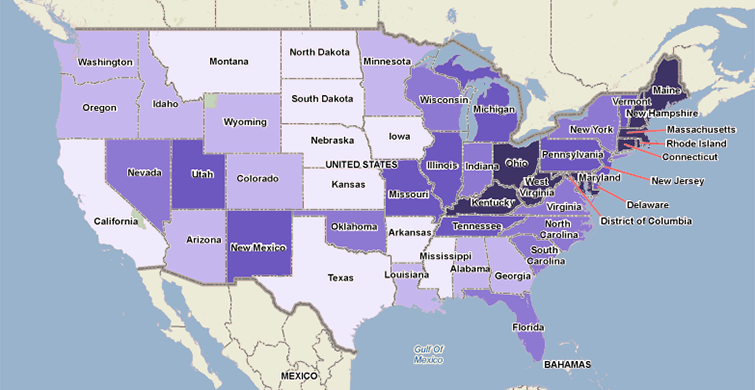Opioid Addiction in Your Community

Addiction to opioid drugs—primarily heroin and prescription drugs such as oxycodone—has been on the rise over the past decade in the United States. Because the introduction of fentanyl, a powerful synthetic opioid, has made opioid addiction much more deadly, many are referring to opioid addiction as a public health crisis or even an epidemic. The story of opioid addiction and its deadly consequences is not the same everywhere, however. Some areas have much higher rates of deaths from opioids than others, but even areas with high rates of opioid overdoses have important distinctions.
We’ve spent a lot of time recently working with new opioid data, so here’s a deeper look into the situation.
The Big Picture
As of 2016 (the most recent year of regional data), two clusters of high opioid overdose rates dominate the U.S. map—most of New England and a cluster centering on West Virginia.
(Note: Extreme undercounting in Philadelphia—which will be discussed in a later blog post—would likely bump Pennsylvania up into top bracket.)
A chart of the top ten states for rate of death from opioid overdose over time shows that these deaths rose slowly from 2000 to 2012, and then increased dramatically from 2013 to 2016 (according to data from the National Center for Health Statistics at the CDC).
A Closer Look at Fentanyl
Deaths from fentanyl are overwhelmingly contributing to the uptick in the overall death rate from opioid overdose. Fentanyl is a synthetic opioid that can be prescribed for pain management or produced and sold illegally, and may even be sold mixed in with illegal drugs like heroin without a user’s knowledge. This chart shows that deaths from fentanyl or other synthetic opioids outpace deaths from any other opioid type in each of the states with the highest death rates from opioid overdose (data from CDC NCHS).
The prevalence of deaths from overdoses on fentanyl and other synthetic opioids is a relatively recent phenomenon. States that had too few deaths to report in this category before 2013 shot to the top of the list over the following few years (see the chart below, with data again from the CDC NCHS). Perhaps most tellingly, the states with the top ten highest rates of death from synthetic opioid overdose are exactly the same as those with the top ten rates for overall opioid overdoses.
Heroin and Oxycodone
The bar chart above also shows that states exhibit different patterns with regards to other major opioid types. In West Virginia, the state with the highest opioid overdose death rate, more people die by overdosing on natural and semi-synthetic opioids such as oxycodone than die from heroin overdoses. “Natural and semi-synthetic opioids” includes many drugs commonly prescribed for pain, such as morphine, codeine, oxycodone, or hydrocodone. These medicines are very common, and include brand name prescriptions that are often prescribed after dental work and surgery.
Perhaps counterintuitively, places with the highest rates of opioid prescriptions do not always coincide with the places where people are dying of overdoses on natural and semi-synthetic opioids like those prescribed for pain. Alabama, for example, had the highest rate of prescriptions of opioids in 2016, but was ranked 47th for its rate of deaths from the same year.
Prescription rates of opioids peaked in the U.S. in 2012 (CDC NCHS). This peak was presumably in response to new policies put in place in response to the rising rate of death from overdose on these drugs.
Nationally, the decline in prescription rates for opioids was followed by a two year decline in the number of deaths from overdose on these drugs, but now these deaths are at an all time high. This story varies from state to state, however. Kentucky, for example, had a peak of deaths in 2011, the same year of their maximum prescription rate. While the death rate is slowly rising again, it is not yet back to peak levels. West Virginia, another state with a very high rate of deaths from overdose on this kind of opioid, experienced a large peak in deaths in 2011, and may be declining. For context, the rate of deaths from overdose on oxycodone and other natural and semi-synthetic opioids is 50% higher in West Virginia than in Maryland, the state with the second highest rate.
A national uptick in deaths from heroin overdose began around 2010, which was closely followed by a rise in overdoses from fentanyl, which began in 2013. Because the data on deaths from drug overdoses is sourced from death certificates, and many death certificates list more than one cause of death, at least some of the uptick in both heroin and fentanyl deaths could be because some people are overdosing on both at the same time.
The data shows us that the story of opioid addiction is not a simple one. Nationally, we see that what began as a slow and steady rise of opioid prescriptions preceded a rapid increase in deaths from many different types of opioids. This national story is even more complex at local levels. Deaths from the most potent kinds of opioids are very concentrated geographically. The data highlights how critical it is for local policymakers to understand the unique pictures of opioid addiction in their communities, and how they may differ from those other areas.
For more information on what data is available, take a look at our last post here.